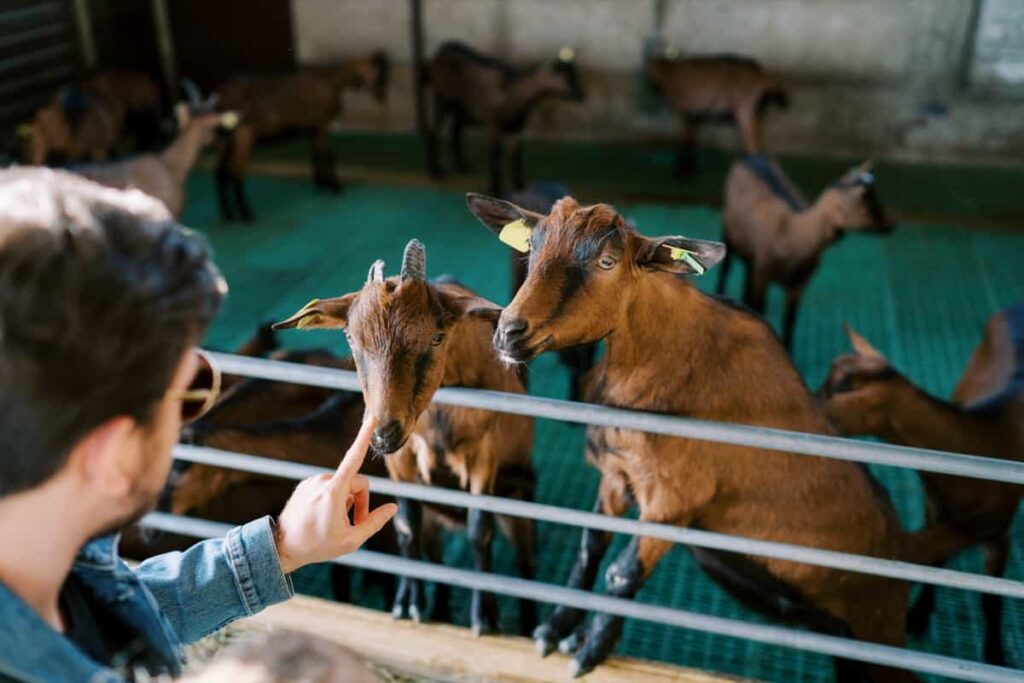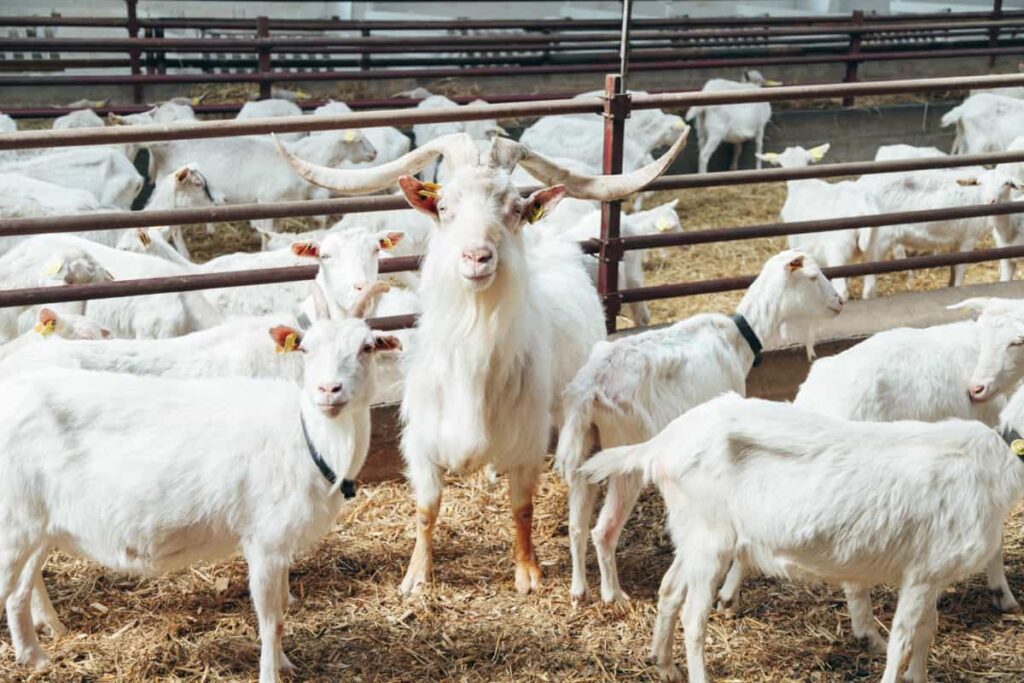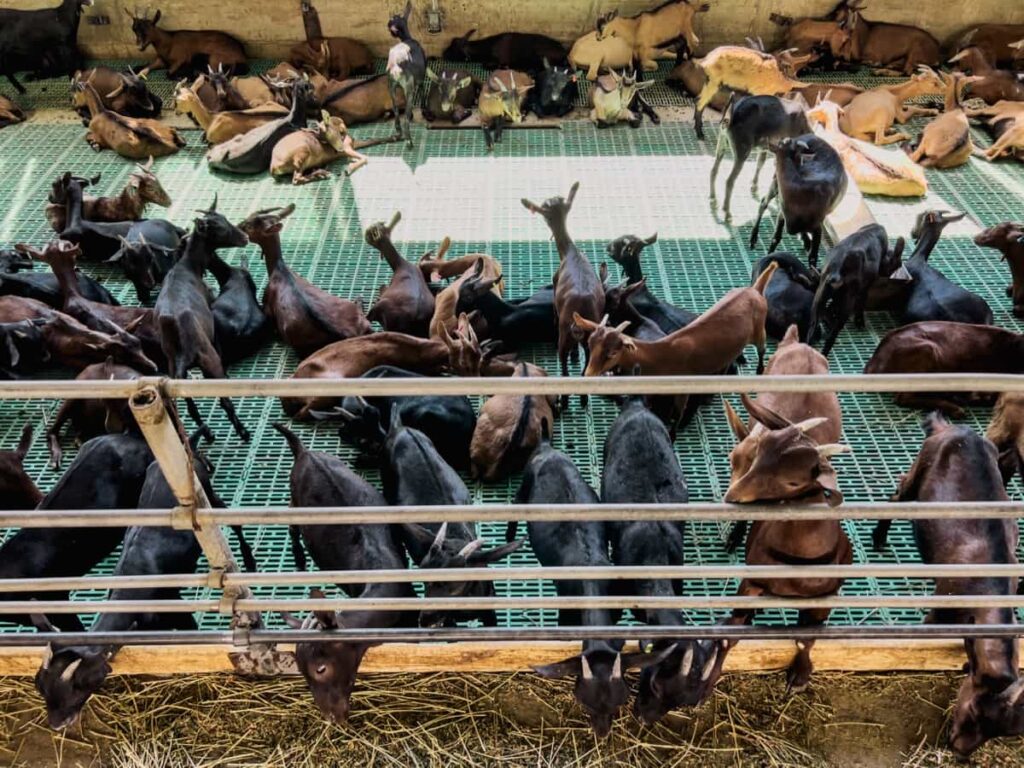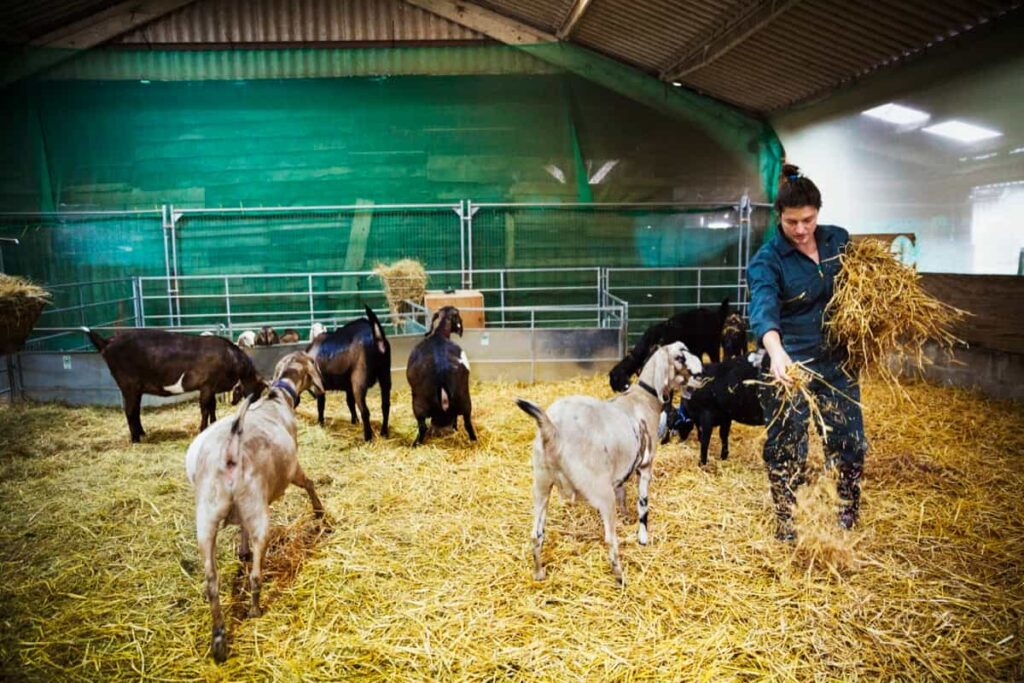Maharashtra’s goat farming, a vital agricultural sector, thrives with diverse breeds and benefits from supportive government policies. This blog explores its current state, the breeds prevalent in the region, and the government’s role in enhancing this crucial industry.

Maharashtra Goat Farming
Overview of the Industry’s Current Status
Maharashtra’s goat farming industry is a profitable and sustainable venture, with a rich diversity of breeds and a high demand for goat products. Popular breeds include Osmanabad, Sangamneri, Kokan Kanyal, and Berari. Benefits include low investment, high returns, government support, and environmental benefits.
However, challenges include disease outbreaks, predators, and marketing problems. Diseases can cause mortality, reduced growth, and infertility, while predators can cause losses and injuries. Goat farmers also face competition from other states and intermediaries who exploit them. Despite these challenges, with proper planning, management, support, and innovation, goat farming can become a more profitable and sustainable venture in Maharashtra.
Different Breeds of Goats Found in Maharashtra and Their Characteristics
Osmanabadi Goat
- Origin: Osmanabad district, Maharashtra
- Appearance: Predominantly black coat; may have white, brown, or spotted variations
- Features: Long pendulous ears, backward-curved horns
- Purpose: Primarily meat; also good milk producer
- Milk Yield: Up to 1.5 liters per day
Sangamneri Goat
- Origin: Sangamner taluka, Ahmednagar district, Maharashtra
- Appearance: White coat with black or brown patches (head, neck, legs)
- Features: Medium-sized ears, twisted upward-pointing horns
- Purpose: Dual-purpose for meat and milk
- Milk Yield: Up to 2 liters per day
Konkan Kanyal Goat
- Region: Konkan area (Raigad, Ratnagiri, Sindhudurg districts), Maharashtra
- Appearance: Black coat with white spots (face, ears, legs)
- Features: Short ears, backward-directed horns
- Purpose: Mainly meat; some milk production
- Adaptation: Suited to coastal climate and terrain
Other Notable Breeds in Maharashtra
- Jamunapari: is known for high milk yield.
- Jakhrana: Distinct for its unique appearance
- Malabari: Adaptable, dual-purpose breed
- Sirohi: Hardy, suitable for tough terrains
- Sojat: Fast-growing, meat breed
In case you missed it: Growing Jowar (Sorghum) Organically in Maharashtra: Step-By-Step Cultivation Process and Production

Government Policies and Support for Goat Farming in Maharashtra
Maharashtra Sheep and Goat Development Scheme (MSGDS)
- Objective: Advanced goat farming with scientific approaches
- Key Benefits: Financial aid for establishing goat farms And Expert guidance for farm management.
- Primary Aims
- Encourage livestock sector entrepreneurship.
- Boost farmer income and quality of life
- Improve goat breed quality and genetics.
- Create vital infrastructure for goat farming.
Training and Technical Support
- Purpose: Train farmers in best practices for goat farming
- Areas of Focus
- Selecting appropriate goat breeds
- Managing goat health and wellbeing
- Effective feeding strategies
- Market-oriented tactics
- Approach: Organizing educational workshops and training sessions
- Result: Farmers gain essential skills for a thriving goat farming business
Enhancing Market Linkages and Product Value
- Strategies: Build strong market networks and encourage the production of value-added goat products like milk, cheese, and meat
- Execution Plan
- Forming and promoting farmer cooperatives and producer organizations
- Assisting in the development of the entire value chain
- Advantages: Access to broader markets and diversified income opportunities for goat farmers
Financial Assistance and Incentives Provided by the Government
Infrastructure Subsidies for Goat Farming
- Goal: Set up advanced and fully equipped goat farms
- Support Offered: Subsidies for constructing essential farm infrastructure like sheds, feeders, and storage units.
- Impact: Eases financial constraints and motivates investments in goat farming
Financial Assistance for Purchasing Goats
- Support Type: Financial assistance for goat acquisition
- Intention
- Facilitate the purchase of high-quality breeding goats.
- Upgrade the genetic quality of goat herds.
- Outcome: Enhanced farm productivity and increased profitability
Role of Maharashtra State Agricultural University in Developing and Improving Goat Farming Practices
Maharashtra State Agricultural University (MSAU), also known as Mahatma Phule Krishi Vidyapeeth (MPKV), is a leading institution in agriculture and allied sciences. It has been instrumental in improving goat farming practices in Maharashtra through initiatives such as promoting dual-purpose breeds like Osmanabadi, Sangamneri, Surti, Konkan Kanyal, and Boer, developing breeding policies for goat improvement and conservation, providing training to farmers, entrepreneurs, and extension workers, conducting research on goat production, and establishing linkages with other institutions for collaborative research.
In case you missed it: Growing Pomegranate Organically in Maharashtra: Farming Practices and Production Guide

MSAU has also contributed to the empowerment of goat farmers by enhancing their knowledge, skills, and income through innovative practices. It has also raised consumer awareness about the nutritional and health benefits of goat products. The university aims to make goat farming a viable and attractive enterprise for Maharashtra farmers.
Challenges Faced by Goat Farmers in Maharashtra and How the Government is Addressing Them
Goat farming in Maharashtra offers numerous benefits but faces key challenges. Farmers often need essential knowledge and technical skills in breeding, feeding, and disease management, leading to low productivity and quality. A critical issue is the scarcity of food and fodder, particularly during dry seasons, causing malnutrition and reduced milk yield. Additionally, market constraints such as low prices, limited demand, and inadequate value-addition facilities hinder profitability.
To counter these challenges, the Maharashtra government has introduced various schemes. These include the Maharashtra Sheep and Goat Development Scheme (MSGDS) for technical support and financial aid, subsidies for infrastructure, training programs, financial assistance for goat purchase, and initiatives to enhance market linkages and value addition, aiming to empower farmers and enhance goat farming viability.
Impact of Climate Change on Goat Farming in Maharashtra and Adaptation Strategies
Climate change poses significant challenges for goat farming in Maharashtra, impacting productivity and increasing mortality due to factors like heat stress and diseases. To combat these effects, adaptation strategies are essential. These include selecting climate-resilient breeds like Osmanabadi and Sangamneri, enhancing feed and water management, improving healthcare and disease prevention, and providing adequate housing and shelter.
Additionally, diversifying income sources through integrating goat farming with other agricultural activities is crucial. Effective implementation of these strategies requires support from the government, research bodies, and NGOs to ensure sustainable goat farming in Maharashtra’s changing climate.
Market Trends and Opportunities for Goat Farmers in Maharashtra
Maharashtra is one of India’s largest consumers of goat meat, with an annual consumption of about 400,000 tonnes. The demand for goat meat is expected to increase due to population growth, urbanization, income growth, and changing food preferences. The average price of goat meat in Maharashtra is around Rs. 600 per kg, higher than the national average of Rs. 450 per kg.
Goat milk, rich in calcium, protein, and minerals, is also in high demand due to its health benefits. The average price of goat milk in Maharashtra is around Rs. 80 per liter, higher than the national average of Rs 50 per liter. Goat leather, a soft, durable, and attractive by-product, is also in high demand, especially in urban areas with rapidly changing fashion trends.
Collaboration between Farmers, Government, and Private Sector to Boost Goat Farming in Maharashtra
Goat farming in Maharashtra is a lucrative and sustainable enterprise that can provide income and nutrition to the rural poor. However, it faces challenges such as low productivity, high mortality, lack of quality feed and fodder, inadequate veterinary services, poor marketing infrastructure, and low-value addition. To overcome these challenges, a collaborative approach is needed among farmers, the government, and the private sector.
Initiatives such as the Maharashtra State Rural Livelihoods Mission (MSRLM), the Goat Trust, and the private sector have been implemented to promote goat farming. The MSRLM provides financial assistance, capacity building, technical support, and market linkages to goat farmers. The private sector, such as Parag Milk Foods, has also invested in goat farming, offering products like cheese, yogurt, and ghee.
Future Prospects and Sustainability
Maharashtra’s goat farming is a profitable and sustainable livestock enterprise, particularly in drought-prone areas. Goats provide various products, such as meat, milk, wool, skin, and manure, which are in high demand and valued in the market. The state has a large population of goats, mainly reared by small and marginal farmers, landless laborers, and women self-help groups.
In case you missed it: Growing Banana Organically in Maharashtra: Cultivation Practices and Production Management

The state government provides various schemes and subsidies for goat farming, such as the Navinypuarn Scheme, which distributes milch animals, semi-stallfed goats, and poultry birds to eligible beneficiaries. Goat farming in Maharashtra can contribute to socio-economic development by providing employment opportunities, income generation, women empowerment, and poverty alleviation. It also enhances ecological balance by preventing soil erosion and promoting biodiversity.
Frequently Asked Questions (FAQ) on Maharashtra Goat Farming
How Can Farmers Improve Goat Health and Productivity?
Regular vaccinations, proper feed, hygiene maintenance, and disease monitoring are key to maintaining goat health and productivity.
What Are the Common Diseases Affecting Goats In Maharashtra?
Common diseases include Peste des Petits Ruminants (PPR), foot and mouth disease, and parasitic infections.
Conclusion
Maharashtra’s goat farming, featuring resilient breeds like Osmanabadi and Sangamneri, thrives under government schemes like MSGDS, offering financial and technical support. This sector, crucial for rural livelihoods, adapts to climate challenges with strategic breed selection and sustainable practices.
- Aquaponic Farming at Home: A Step-By-Step Guide
- Profitable Village Farming Business Ideas in 2024
- High-Yield Aquaculture: Fast-Growing Fish for Farming
- Effective Fish Pond Construction Techniques for Beginners
- Irrigation and Water Management in Pineapple Farming
- Blossom to Harvest: Mastering Flowering and Pollination in Papaya Farming
- Pig Fattening Essentials: From Selection to Sale for Beginners
- Raising Wagyu Cattle: A Complete Guide for Premium Beef Production
- Soil Types and Their Water Holding Capacity
